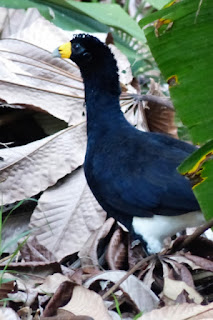 |
| Anthurium lilies growing in a sheltered garden on the grounds of my apartment. |
... and this...
 |
| Royal Terns roosting on a fishing boat just a few yards from my doorstep. |
I eat fresh, sun-ripened fruit (I'm absolutely addicted to papayas)
I walk on the beach, most days I swim, some days I snorkel, every day I do a bit of work. And the end of each day looks something like this:
 |
| Kids playing on the beach at sunset. |
This 2' x 3' table is my studio:
It's not much in terms of square footage but the view is pretty spectacular!
Grenada is home to about 95,000 people, and the ones I have met have been friendly, congenial folks. The island was basically flattened by Hurricane Ivan a few years ago, which destroyed, among other things, the nutmeg trees this place is famous for (they're now re-growing), and a couple of decades prior to that the island experienced internal conflict that saw many lives lost and brought about an unprecedented invasion of U.S. troops. A casual visitor would never know this place has such a troubled past, but the way of time is to keep moving forward, healing old wounds as it goes.
Being here has caused me to reflect on my life as an artist and just how fortunate I am. I work hard but I never fear that I won't have food or shelter, or that I will go without the other basic necessities of life. I have met people who call this place home, who lived through political upheaval that included the violent execution of their prime minister, and whose homes were destroyed by the forces of nature. I have spoken with people whose livelihood depends on tourist dollars, and some of their stories make me sad and ashamed. Through anecdotes and first-hand observation, I have learned and seen just how rude many visitors are, and how poorly some of them treat local folks who are trying to keep body and soul together by selling cold drinks on the beach, or fresh-cooked lunches, or tours of the island, or baskets of spices, or hand-made necklaces. Many of the perpetrators appear to be cruise passengers whose ships make one-day calls in Grenada's beautiful harbour of St. George. I can only suppose they have no empathy for what it's like to really struggle for the next meal, the next rent payment, the next pair of shoes for a child in a place where job options are few. If they did, they would at least be polite about saying "no thank you" and maybe share a few words of conversation instead of pretending they can't hear or see the person in front of them who is offering their services. I have also heard sad stories of cruise ship workers who spend long months at sea, far from their families, working endless, difficult shifts because that's one of the few job options available. Some of them are even indentured to "brokers" who find the cruise ship jobs for them, and they must work off those fees before they can begin to keep any hard-earned money for themselves. I realize I am very lucky to have the choices I do. I know all about working long shifts, but in my case it's a labour of love and the benefits of being self-employed include the opportunity to take time in the dead of the Canadian winter to head south to places like this. I am indeed fortunate and I am continually grateful for my good fortune. I do not, for one moment, take it for granted.
But Grenadians appear to be a cheerful, hardworking, resilient bunch who don't need me to stick up for them. And anyway, I'm sure that some day Kharma will do its thing and the tables will turn. I am of the belief that this is one of the most beautiful places on earth and hopefully one day, in combination with good jobs and a strong economy that isn't dependent on tourism, it could fulfil its potential as paradise! In the mean time, I do my best to be an aware visitor to this place, buying local products from local people (the fresh fruits and vegetables in the St. George market are second to none) including the rent for my apartment which is owned by a Grenadian couple. It's the least I can do in payment for being able to spend time in their beautiful country.
While here, I started and completed my final artwork of 2012: a complicated drawing of a tropical songbird - a Palm Tanager - in a setting of (appropriately enough) palm fronds.
As I struggled through it, I asked myself "what was I thinking?" to I undertake such a daunting project. Maybe I needed to challenge myself, to work hard while enjoying this idyllic place where visitors can bask, oblivious to their good fortune, while locals hustle for their daily wage. At any rate, this drawng represents the culmination of my work to date as of December 31st, 2012.
As the sun goes down on this final day of the year, I bid farewell 2012 while soaking up the beauty of a Grenadian sunset. I welcome 2013 with the challenges I know it will bring and the rewards for which I am hopeful. And I'm truly thankful for the life I have.








.jpg)











.jpg)
+(510x303).jpg)
.jpg)



.jpg)
.jpg)
.jpg)
.jpg)




.jpg)












